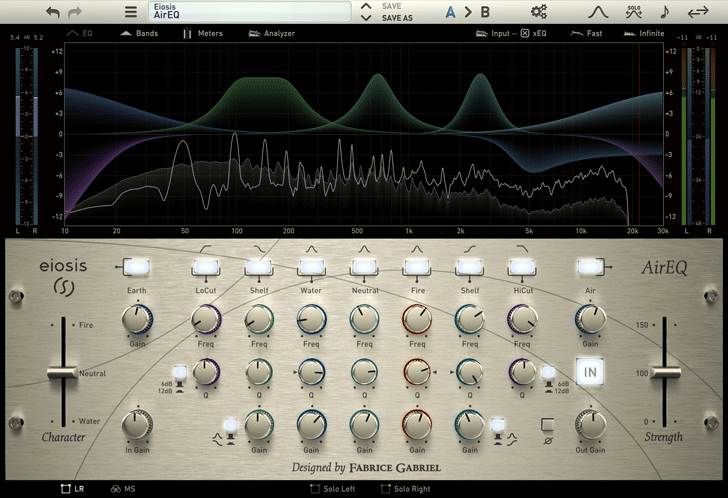
Barry's Mix Magazine Equipment And Software Reviews
Barry's Massive Discography And Engineering Career
Barry's Music Connection Magazine Reviews
Barry's Resolution Magazine Reviews
Eiosis AirEQ Premium Equalizer Plug-In
By Barry Rudolph
 |
| -- Eiosis AirEQ Premium Equalizer Plug-In |
AirEQ Premium (version 1.0.22.3 for Mac tested here) is a multi-channel equalizer plug-in with five bands of parametric EQ, each with identical frequency ranges of 10 Hz to 30 kHz, +/-18 dB boost/cut, and variable Q from 0.1 to 7.0 in two ranges. The three center bands are switchable between bell and steep bell types. The two outer bands are switchable between bell, shelf and steep bell shapes and can overlap each other to function as a tilt equalizer.
There are also high-cut (20 Hz to 30 kHz) and low-cut (5 Hz to 10 kHz) filters with selectable 6 or 12dB per octave curves and an adjustable Q range of 0.35 to 4.0. For these filters, Q governs the height and width of the resonant peak they exhibit just before cutoff.
I liked the euphonic-sounding single-knob Air band equalizer with its gentle Baxandall curve starting at about 1kHz. Air is "counterpoised" by Earth, a single-knob low-frequency EQ starting at about 200 Hz that emulates transformer phase behavior. I found it clever that each of the nine section bypass buttons have embedded drop-down menus for setting that section's particular behavior. I am also getting used to the Auto-On feature: Any EQ/filter section is automatically activated the moment I clicked on any of its parameter controls.
To keep track of all equalizers and filters deployed, AirEQ has a beautiful onscreen display with a real-time input/output spectrograph running behind color-coded EQ curves that match the highlighted surrounds of their respective parameter knobs. For me (and my bad eyes), I would like these colors to be brighter and more saturated. The algebraic sum of all EQ sections is graphically represented by a (switchable) solid white curve.
AirEQ also features the unique Character and Strength controls. The Character fader globally modifies the shape of all equalizer sections at the same time. Character does not affect the Air, Earth and the Hi/Lo Cut sections, and you can exclude any EQ section from Character's purview and use the band's local character control instead.
Character's default center-fader position is called Neutral for the default bell shape. As the Character fader is moved up toward the Fire position, the shape of all bands becomes more focused while being smoother at the top of the curve. As the fader goes toward Water, the shape becomes fatter at the top of the curve.
The Strength fader functions like a wet/dry control--you can change the boost/cut values of all the sections at the same time. Strength changes are not indicated on the graphical display or the parameter knobs' positions (too bad), and you can also exclude any section(s) from Strength's control.
I found after intensive microscopic EQ scrutiny and carving that I sometimes had overdone it--so backing down Strength from the center 100 percent (default) position usually fixed it and my tendencies to over EQ. Strength ranges from 0 percent to 150 percent.
With a plug-in this deeply featured, all parameter ranges, control knob setups, GUI layout, unhide/hide the spectrograph, metering setup (including K-Metering), FFT analysis tweaks, snapshots, preset editing and naming happens within the plug-in's Preset Management and Configuration menus. Presets saved here can be used across different DAW platforms in your computer. In addition, AirEQ has the standard Pro Tools plug-in preset GUI framework, and all parameters can be automated.
Into the Studio
I liked to automate both the Character and Strength faders when dealing with problematic vocal tracks. For a couple of nasty peak frequencies on my singer's lead vocal track, I set up two narrow notches (344 Hz, at -3.82 dB and 1.65 kHz at -4 dB) and excluded them from the Strength fader.
My singer was dark-sounding in the song's verses but tended to be strident and overbearingly shrill in the choruses. So I set a 6.3 kHz +4 dB shelf, a 3 dB boost from the Air section, 12 dB/Oct at 50 Hz from the Low Cut section (also excluded from Strength). In the verses I automated Strength fader higher and backed down in the choruses. For this vocal I found the Character control best set toward the Water end in the quieter verses--a smoother, more natural sound reminiscent of a Pultec EQ.
Next I tried AirEQ Premium in M/S mode as a program EQ for "faux-mastering" of a stereo mix. By right-clicking on any section's bypass button, that section can be assigned to process either the Mid or Side signals in the M/S mode. By selecting Band Solo mode in Settings and shift-clicking a frequency knob, I could sweep up/down with max gain and sharp Q to verify "frequencies of interest" without affecting my previously set parameter values for that section. This is a smart feature that other EQ plug-in designers should copy.
In the Multi-channel Toolbar I soloed the Mid channel to equalize all center-panned audio by selecting two EQ sections. Soloing the Side, I selected and used a lot of the Air Band section and opened up the stereo width without phase issues. When AirEQ is inserted into a multichannel stem, the process is similar: simply click to assign equalizer sections to set EQs for: L/R, LsRs, Center, or LFE channels with link/unlink option.
There are a lot of features packed into AirEQ Premium. It can be subtle, stealthy and beautiful-sounding or super-focused with surgical precision. It is not a linear phase EQ but uses minimal CPU, runs rock solid and sounds awesome.
|
|
|
|
|
|